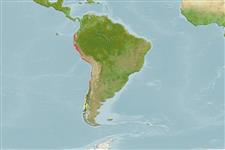Elasmobranchii (Haie und Rochen) (sharks and rays) >
Carcharhiniformes (Ground sharks) >
Triakidae (Houndsharks) > Triakinae
Etymology: Mustelus: Latin for weasel, an ancient name for sharks, possibly referring to the pointed snouts, swift movements and/or rapacious feeding behavior of smaller predatory sharks [strictly not tautonymous with Squalus mustelus Linnaeus 1758 since type was designated by the ICZN] (See ETYFish); whitneyi: In honor of American fisheries biologist Richard R. Whitney (1927-2011), for his teachings and guidance during the author’s study of sharks (See ETYFish).
Eponymy: Dr Richard R Whitney (1927–2011) was a fisheries biologist. [...] (Ref. 128868), visit book page.
Environment: milieu / climate zone / depth range / distribution range
Ökologie
seewasser demersal; tiefenbereich 16 - 211 m, usually 70 - 100 m (Ref. 9253). Tropical; 1°N - 45°S, 83°W - 70°W
Southeast Pacific: Ecuador to southern Chile.
Size / Gewicht / Alter
Maturity: Lm ? range ? - ? cm
Max length : 87.0 cm TL (female)
An offshore bottom-dwelling shark found on the continental shelf. Prefers rocky bottom around islands. Feeds on crabs, mantis shrimp, and small bony fishes. Viviparous, with 5 to 10 young per litter. Size at birth about 25 cm.
Life cycle and mating behavior
Geschlechtsreife | Fortpflanzung | Ablaichen | Eier | Fecundity | Larven
Viviparous (Ref. 244). Distinct pairing with embrace (Ref. 205).
Compagno, L.J.V., 1984. FAO Species Catalogue. Vol. 4. Sharks of the world. An annotated and illustrated catalogue of shark species known to date. Part 2 - Carcharhiniformes. FAO Fish. Synop. 125(4/2):251-655. Rome: FAO. (Ref. 244)
IUCN Rote Liste Status (Ref. 130435: Version 2024-1)
Bedrohung für Menschen
Harmless
Nutzung durch Menschen
Fischereien: hoch kommerziell; Sportfisch: ja
Tools
Zusatzinformationen
Download XML
Internet Quellen
Estimates based on models
Preferred temperature (Ref.
123201): 12.6 - 15.6, mean 15 °C (based on 15 cells).
Phylogenetic diversity index (Ref.
82804): PD
50 = 0.5000 [Uniqueness, from 0.5 = low to 2.0 = high].
Bayesian length-weight: a=0.00224 (0.00104 - 0.00482), b=3.14 (2.97 - 3.31), in cm total length, based on LWR estimates for this Genus-body shape (Ref.
93245).
Trophic level (Ref.
69278): 3.7 ±0.0 se; based on diet studies.
Widerstandsfähigkeit (Ref.
120179): sehr niedrig, Verdopplung der Population dauert mehr als 14 Jahre. (Fec=4).
Fishing Vulnerability (Ref.
59153): Moderate to high vulnerability (55 of 100).
Nutrients (Ref.
124155): Calcium = 33.5 [9.6, 163.5] mg/100g; Iron = 0.511 [0.154, 1.840] mg/100g; Protein = 21 [19, 23] %; Omega3 = 0.0958 [, ] g/100g; Selenium = 83 [22, 289] μg/100g; VitaminA = 13.1 [5.0, 32.5] μg/100g; Zinc = 0.954 [0.422, 1.897] mg/100g (wet weight);
